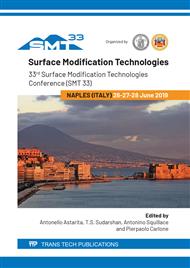[1]
C. Leyens, M. Peters, Titanium and Titanium Alloys: Fundamentals and Applications, Willey-VCH, Weinheim, (2003).
Google Scholar
[2]
A.P. Mouritz., Introduction to aerospace materials. Woodhead Publishing Limited, Cambridge (2012).
Google Scholar
[3]
C Reményi, S Staudacher, Systematic simulation based approach for the identification and implementation of a scheduling rule in the aircraft engine maintenance. International Journal of Production Economics 147A (2014) 94-107.
DOI: 10.1016/j.ijpe.2012.10.022
Google Scholar
[4]
C. Soares. Gas Turbines, Second Edition: A Handbook of Air, Land and Sea Applications. Buttherworth-Heinemann, Oxford, (2014).
Google Scholar
[5]
S. Grainger, J. Blunt, Engineering Coatings. Design and Application. Abington Publishing (2nd Ed.), Cambridge, (1998).
Google Scholar
[6]
RW Jr.Messler, Principles of Welding: Proceses, Physics, Chemistry and Metallurgy, JohnWiley & Sons Inc., (1999).
Google Scholar
[7]
L. Pawlowski, The Science and Engineering of Thermal Spray Coatings. Second Edition., John Wiley & Sons Inc., New York (2008).
Google Scholar
[8]
VK. Champagne, The Cold Spray Materials Deposition Process: Fundamentals and Applications. Woodhead Publishing in Materials, Cambridge, (2007).
Google Scholar
[9]
J. Villafuerte, Modern Cold Spray: Materials, Process, and Applications, Springer, Ontario, (2015).
Google Scholar
[10]
Moridi, S. M. Hassani-Gangaraj, M. Guagliano, M. Dao, Cold spray coating: review of material systems and future perspectives. Surface Enginering 30 (6) (2014) 369-395.
DOI: 10.1179/1743294414y.0000000270
Google Scholar
[11]
M. A. Garrido, P. Sirvent, A. Rico, C. J. Múnez, P. Poza, Response of Cold Sprayed Ti6Al4V Coatings to Solid Particle Erosion and Micro-Scratch Wear Processes, Materials Science Forum 941 (2018) 1680-1685.
DOI: 10.4028/www.scientific.net/msf.941.1680
Google Scholar
[12]
P. Poza, P. Sirvent, A. Rico, C. J. Múnez, M. A. Garrido, Oscillating Contact Wear in Cold Sprayed Ti6Al4V Coatings for Aeronautical Repairs, Materials Science Forum 941 (2018) 1686-1691.
DOI: 10.4028/www.scientific.net/msf.941.1686
Google Scholar
[13]
D.Verdi, M.A. Garrido, C.J. Múnez, P. Poza, Influence of exposure at high temperature on the local scratch mechanisms in laser cladded Inconel 625-base metal matrix composite coatings, Journal of Alloys and Compounds 733 (2018) 69-81.
DOI: 10.1016/j.jallcom.2017.10.291
Google Scholar
[14]
D.Verdi, M.A. Garrido, C.J. Múnez, P. Poza Cr3C2 incorporation into an Inconel 625 laser cladded coating: Effects on matrix microstructure, mechanical properties and local scratch resistance, Materials & Design 67 (2015) 20–27.
DOI: 10.1016/j.matdes.2014.10.086
Google Scholar
[15]
Hutchings and P. Shipway, Tribology. Friction and Wear of Engineering Materials, Second Edition, Buttherworth-Heinemann, Oxford, (2016).
Google Scholar


